Since the world embraced remote work, geographical barriers between talent and job openings have all but disappeared. There’s never been a better time to invest in foreign workers.
International workforces are more productive, more inclusive, and more sustainable. Culturally diverse companies also boast more perspectives, ideas, and insights, leading to more innovation and better decision-making.
Still, unlocking a global talent pool isn’t without its challenges. Payroll, taxes, and compliance vary from country to country and can be a tricky maze to navigate on top of the regular challenges of hiring employees who are a good fit for your company.
As a company on a mission to help teams work better from anywhere, we’ve been hiring foreign employees for years, and we made this guide as a candle in the dark to help you feel confident as you start looking for your next foreign employee.
TL;DR — Key Takeaways
The main benefits of hiring foreign workers include more diversity, access to a global talent pool, better team decision-making, and higher financial returns.
The main challenges of hiring employees internationally include complexities with legal, payroll, and compliance aspects for the company.
Foreign employees can be hired as freelancers, under foreign subsidiaries, or through an employer of record. The right option will ultimately depend on your needs as a company.
When building a remote hiring process for foreign workers, consider accommodating cultural differences, time zones, and fair compensation packages.
The benefits of hiring foreign workers
Global, diverse teams generate 19% more revenue, solve problems faster, and have higher employee satisfaction. If your international workforce is also remote, you can expect 35-40% higher productivity, 25% lower employee turnover, and a saving of $11,000 per employee per year in overhead costs.
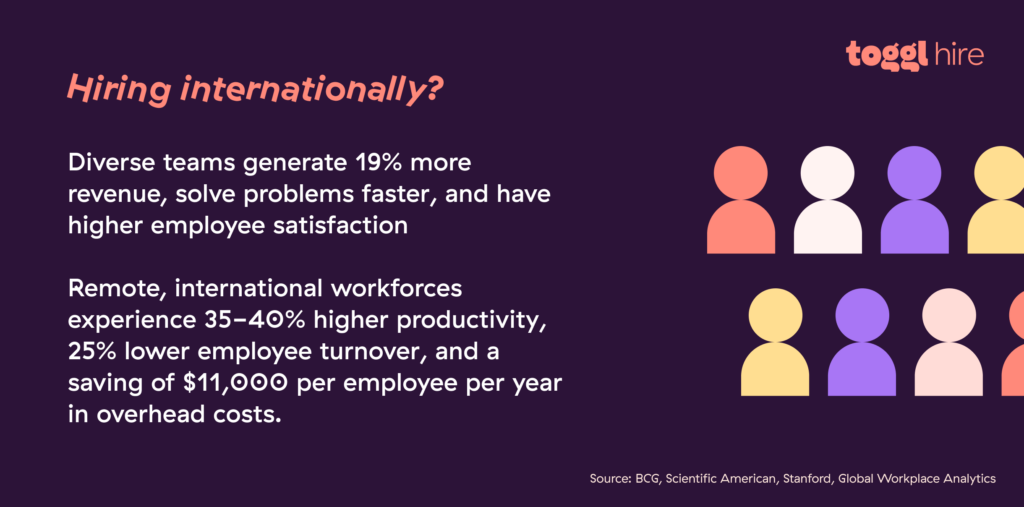
Diversification and global perspective
International employees bring unique perspectives and insights based on their diverse cultural backgrounds and experiences. Companies with diverse teams are 35% more likely to outperform their counterparts.
This is because the ability to see something from various points of view helps you understand it better than you ever could from your perspective alone. Whether problem-solving, strategizing, or socializing, this mix of outlooks comes together to foster creativity and innovation that no one person could come to on their own.
A study by Harvard Business Review found that diverse teams are better decision-makers, too. They’re more likely to remain objective, process information more carefully, and innovate more. Ultimately, harnessing cultural diversity makes you more competitive.
Access to a larger talent pool
One obvious benefit of hiring remote foreign employees is tapping into a larger, global talent pool. Fun fact — that was the initial bottleneck that led to Toggl becoming a remote company back in 2006! We realized there are lots of talented people beyond Estonia’s borders, so why not bring them on, too?
Opening your company to remote hiring allows you to find and onboard highly skilled individuals who may not be available in your local job market. Building an international talent pool is a great way to keep these candidates front of mind.
And logically, the wider you cast your hiring net, the stronger the talent in your pool is going to be. Talk about a win-win.
Multilingual advantages for market expansion
If you want to expand into new markets or start working with international clients, hiring people from those places can give you a smooth landing. Cultural sensitivity and fluency in the language will reduce friction with new customers and build your expertise and reputation in the region quickly.
Some benefits of hiring foreign workers from new target markets include:
Speaking the local language(s)
Familiarity with local business culture
Having contacts who can help your business growth
Knowing people who can improve your network on the ground
An understanding of compensation and benefit expectations of local workers
Ultimately, hiring people from other countries can make it easier for your business to start up in new places and make people trust you faster.

Boosting company reputation
Building a global team shows you’re serious about diversity and inclusion. This not only boosts your reputation among industry peers and potential candidates, but it also helps you attract top talent globally.
According to a Glassdoor survey, 76% of job seekers consider diversity an important factor when evaluating job offers. By building a diverse, global workforce, you’re more likely to attract top talent while also positioning yourself as an industry leader to clients and partners.
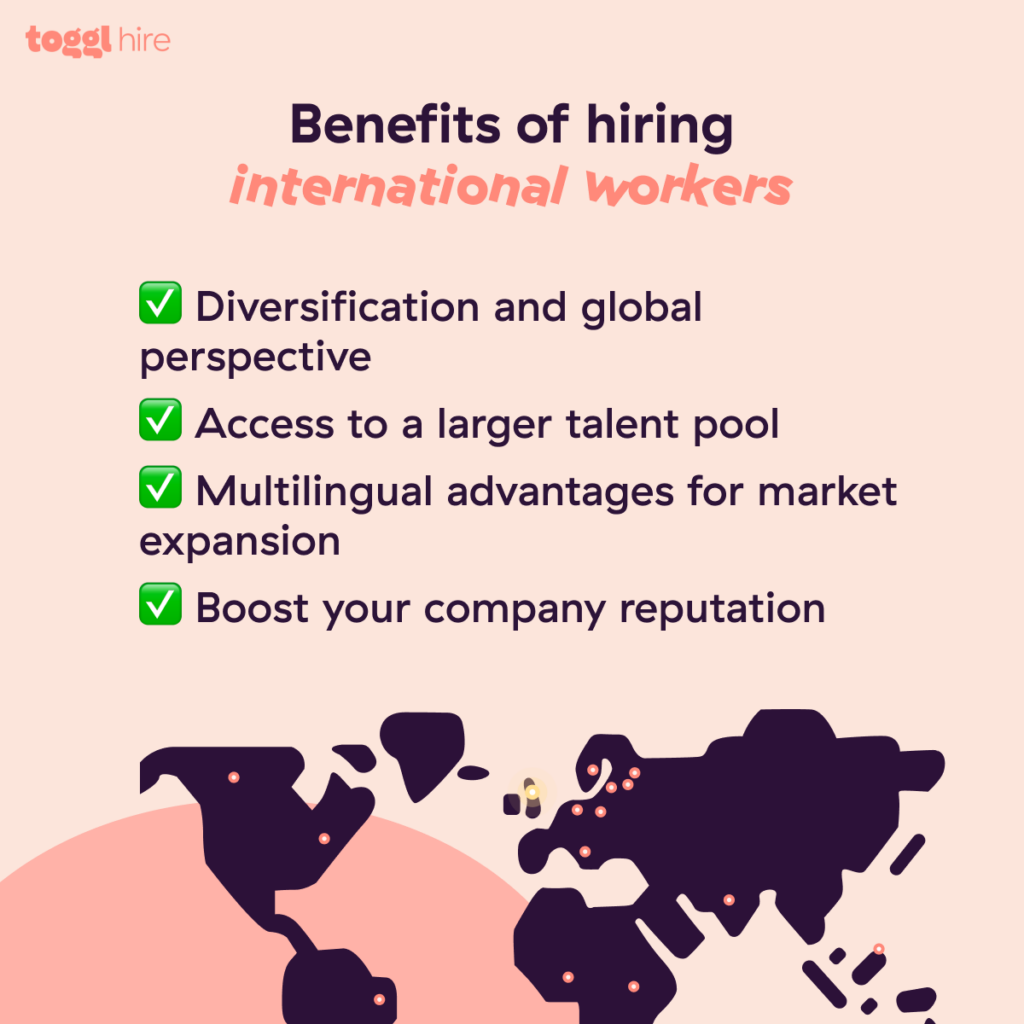
Common challenges of hiring international employees
As with anything in business and hiring, there are drawbacks to consider, too. The biggest issue most companies have is the local laws and regulations in the home countries of the foreign workers you want to bring on board, which can vary a lot depending on the region.
For example, you’ll need to establish whether you’ll need to hire foreign workers as employees or foreign contractors and what kind of visas they’ll need. Payroll and local labor laws are two other important factors to consider. Each country has its own regulations regarding wages, benefits, and working hours, which you want to make sure you’re compliant with.
These issues are why many international companies rely on expert legal and financial advice to mitigate these challenges. They also implement robust payroll and HR software that can handle the complexities of global operations.
International workforce regulations
Workforce regulations like leave policies, working hour limits, and overtime pay vary greatly internationally. To ensure you’re always up-to-date and compliant with local workforce regulations, it might be best to set up a dedicated team of HR and legal experts for each continent you operate in.
You can also outsource this part of your business to an HR partner who can help your company grow in a compliant manner while avoiding penalties, legal issues, or reputational damage.
Managing international payroll administration
Another key challenge of hiring talent from other countries is figuring out how to pay them. How often employees are paid, how much tax is withheld, and what currency should be used are all things that vary across borders.
Some things you should know about your international payroll:
The currency you will be paying in, whether your local currency or your employee’s local currency
Which company bank accounts payments should come from
The method of payment (Will you use a direct bank transfer or a third-party fintech company? Do you need invoices issued before payment?)
What your role and responsibility is to the employee if their home country experiences a sudden economic or political crisis
Many international companies use robust payroll systems to help manage these complex systems. Some great examples of such software are Deel, Remote, and Rippling.
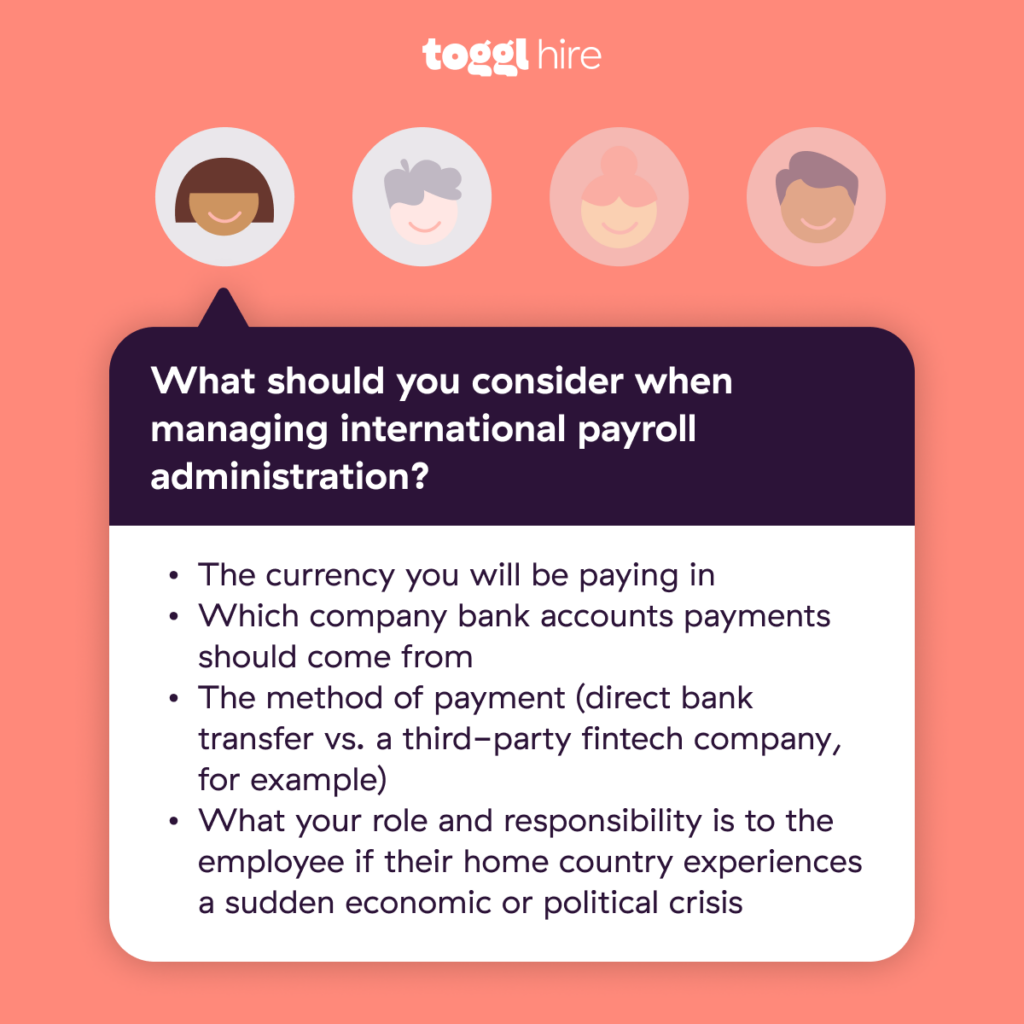
Fair pay issues with a global workforce
The cost of living, average salaries, and relative purchasing power of currencies vary so widely across the globe. This makes managing pay increasingly complex the more markets you hire in. You must thoroughly research equitable compensation and even bring on expert advice if necessary.
Pay transparency is one way you can foster a bit more trust and fairness among both your employees and potential candidates. For example, at Toggl (Hire, Track, and Plan), we always list the salary on our job boards, so applicants know what to expect right off the bat. This amount doesn’t depend on where in the world someone lives.
Other remote companies take even more unique approaches. SafetyWing famously pays all their employees the same salary, regardless of role, seniority, or location.
Optimizing the international hiring process
With an international workforce comes the task of working across international time zones. This logistical challenge can make scheduling interviews and onboarding tricky during the hiring process and scheduling meetings tricky for employees.
Companies should be flexible and accommodating by offering interview times slightly earlier or later than their normal work hours or getting someone more time zone-aligned with the candidate to step in if needed.
Asynchronous hiring tools, like one-way video interviews, can streamline this process, allowing both sides to participate at their convenience.
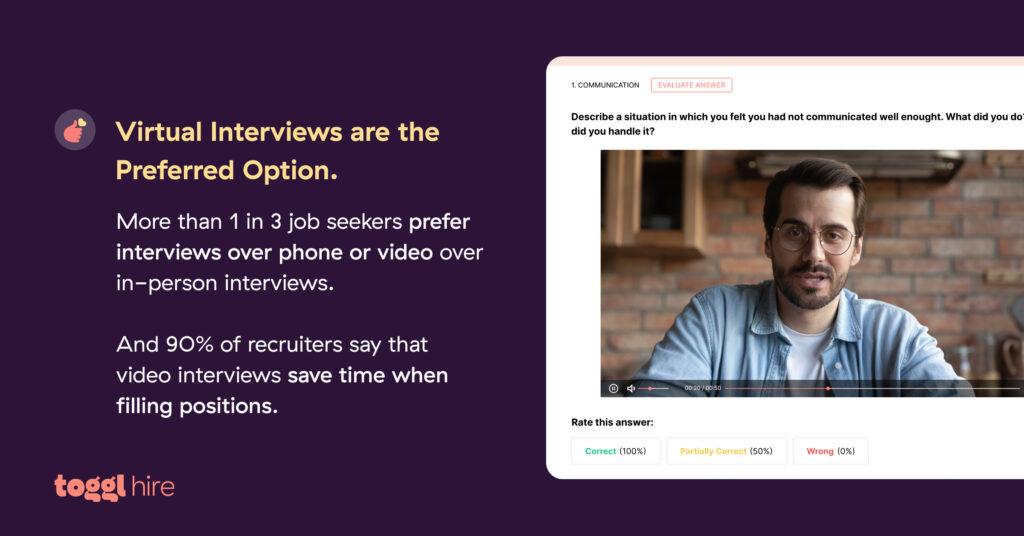
Legal options for hiring international employees
Generally speaking, you normally have three ways you can hire foreign workers. The one most aligned for you will depend on your short-term and long-term needs as a business.
Hire independent contractors
Independent contractors, or freelancers, are hired by a company to help with a specific role, task, or project. They can be hired on an ongoing or fixed-term basis, depending on the nature of the position.
The differences between freelancers and employees are:
Freelancers get paid a gross amount and are then responsible for paying their own taxes from that amount. Employees get paid a net amount, where the company has already withheld all their income and social security taxes.
Freelancers generally don’t receive employee benefits such as sick pay, paternal leave, paid time off, or pension contributions (although you’re free to add that to their compensation package however you see fit — we do at all Toggl companies).
Freelancers must invoice the company to be paid, whereas employees get paid automatically from the company.
The win: Freelancers are generally a great place to start for small startups looking to scale, especially if they need senior input or a specific skill set. The administrative burden of bringing on freelancers is relatively low.
The warning: It’s important to be wary of potential risks like misclassification. You cannot pay people as international contractors if they’re performing the duties of employees. Whether someone is better classified as a contractor or employee will depend on the number of hours worked over a given period, the length of association, and more.
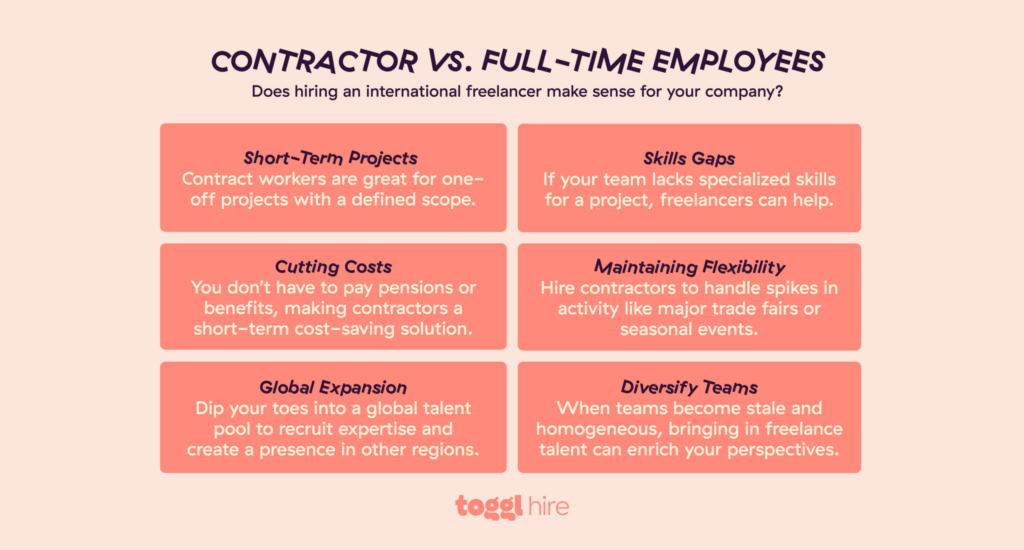
Open a local entity or foreign subsidiary
If you’re expanding globally, you might want to set up international offices in the different countries you’re hiring workers from. This involves creating a legal entity in each country, which all operate under the governing law of each country, but are still part of the same parent company.
The win: A legal entity in foreign markets shows a commitment to integrating into the local business community. Having your own local office also builds trust and reputation on the ground and comes with (often) simpler local administrative and bureaucratic processes, as everything is integrated with the local government.
The warning: This path takes a huge amount of time and resources to implement. Some estimates range from $60,000 to $120,000 in initial set-up costs. Several legal obligations and complexities are also involved in setting up and maintaining a foreign legal entity.
Setting up a foreign subsidiary only makes sense if you know you want to build a deeper relationship with the local market long-term. Because of the startup costs, this option is more realistic for medium- to large-sized businesses rather than newer startups.
Work with an employer of record
An Employer of Record (EOR) is a third-party organization responsible for being the legal employer of foreign workers, including handling payroll, taxes, benefits, and compliance with local employment laws.
The win: This is the fastest and most cost-effective way to get started hiring foreign workers, as you have full peace of mind that you’re 100% compliant. Payroll management is a breeze as it is also outsourced to your EOR, reducing your administrative burden substantially.
The warning: Most EORs charge an upfront set-up fee for each employee. They also usually hold a deposit for each employee, either as a lump sum or as a percentage of the employee’s salary, which you receive back when the employee terminates their working relationship with you. On top of those initial fees, EORs also charge a monthly ongoing fee just for using the service.
Working with an EOR would be beneficial for businesses lacking the resources or expertise to handle international employment complexities themselves. However, since you’re paying employees in many different currencies, some EORs might charge you foreign exchange fees.
A 5-step guide to hire foreign employees
There is no one-size-fits-all process for hiring international employees. It can vary a lot depending on what countries you’re hiring from, the positions that need filling, your industry, and the stage of growth your company is in.
However, we’ve put together a five-step guide to help you get started hiring foreign workers, based on what we think works as a remote company of almost 20 years.
1. Understand employment laws in the target country
Start by researching employment laws in each country you want to hire talent from to avoid penalties or legal issues. Specifically, you need to understand local regulations around:
Minimum wage
Overtime pay
Sick pay
Leave policies
Employer pension and social security contributions
Termination rules
You can usually get this information from local employment lawyers, local HR experts, or government labor websites.
2. Obtain work permits and visas
Without the correct work permits or visas for your international employees, they are technically illegal workers and can get you in big trouble (however, this might vary depending on how you choose to contract international workers — so check with local citizenship and immigration services).
For example, let’s imagine an Estonian company is bringing a US citizen onto the team as a full-time employee.
This typically involves the employer demonstrating that they were unable to find a suitable candidate from within the European Economic Area (EEA) and offering the job to a non-EEA national instead.
Upon providing an employment contract, the Estonian company will have to secure a work permit for the American worker. How this is done depends on the type of work permit needed.
The Estonian company will need to pay social taxes and contributions on behalf of the American worker and assist with any relocation costs.
Now, let’s consider the opposite scenario—an American company bringing on an Estonian hire. You, as the hiring company, will need to:
Apply for a Labor Condition Application (LCA)
Provide all the necessary company statements and requested documents
Fill the petition for a visa on behalf of your EU employee
Once set up, our new EU employees will need to fill in a W8-BEN tax form, as they are foreign workers engaged with a US company.
Of course, processes will differ depending on both the company’s and foreign employee’s home countries. It’s also incredibly different if you decide to hire a foreign worker on a contract basis. In that case, visas aren’t an issue.
What is certain in all cases is that this process is an investment of both time and resources. You can enlist the help of an experienced immigration attorney or citizenship and immigration services if needed.
3. Set up international payroll
Most remote and international companies rely on global payroll software to manage paying foreign workers. Some things you’ll need to consider are exchange rates, payment schedules, and tax laws in different countries to ensure you remain compliant in all countries you’re hiring from.
If you decide to go with remote-focused payroll software, Deel, Remote, and Rippling are great options. If you’d rather get a boutique service, you can partner with a payroll service provider.
4. Create a comprehensive onboarding process
Because they’ll likely work remotely, it’s vital to have a well-planned remote onboarding process for international employees. Think about including:
Cultural training
An overview of company policies
Key tools you should have access to
Introductions to key team members
Check out our remote onboarding checklist article for a comprehensive list! Digital tools and platforms can also facilitate virtual onboarding, but remember to make the process as asynchronous as possible to accommodate wide-ranging time zones.
5. Maintain open and regular communication
It can be easy for foreign employees to feel isolated in a remote work environment. That’s why it’s important to build regular communication with all remote employees. This keeps them engaged, motivated, and connected to the wider team and company mission.
One way you can overcome the challenge of multiple time zones is to offer multiple “social hour” slots during different times, so everyone has the chance to build social bonds beyond work with their colleagues (e.g. 5 pm PST for USA workers, 5 pm CEST for European and African workers, and 5 pm JST for East Asia and Australian employees).

More tips for hiring international employees
Based on everything we’ve covered so far, here are 11 tips for you to start hiring foreign workers and building remote teams with ease.
1. Try asynchronous hiring
Interviewing is the hardest thing to coordinate when hiring remotely. To combat the time zone problem, try recorded video interviews! Candidates record themselves answering your questions, and you can review them at your leisure.
2. Implement skills assessments
Skills assessments help you objectively evaluate a candidate’s abilities. This is key when hiring across different educational or professional backgrounds. With a tool like Toggl Hire, you can also test for soft skills like communication and situational judgment which can help ensure foreign employees will be a good cultural fit for your company.
3. Offer competitive compensation packages
High-quality candidates usually come with a high-quality paycheck that reflects their experience and skills. Ensure you’re aware of local market rates for the roles you advertise and offer fair compensation.
4. Consider working with a professional employer organization (PEO)
Working with a PEO can streamline HR tasks, payroll, and compliance issues, making the process of hiring remote employees more efficient. All you have to do is focus on finding the best person for your open role!
5. Respect cultural differences
Cultural sensitivity becomes more important the more international your organization becomes. Giving remote foreign employees their local holidays off is an easy measure to implement that promotes inclusivity.
6. Don’t forget about employee engagement
Set up a standing check-in with all new hires to ensure they stay engaged and empowered (at Toggl, we call these temperature checks). Ensuring your remote workers feel appreciated, supported, and valued is key to keeping them!
7. Establish clear expectations
All listed job opportunities need to clearly outline the expectations, responsibilities, and requirements of the role. This continues throughout onboarding, too, as clear expectations help keep remote foreign employees on the same page.
8. Leverage social media for hiring
Leverage LinkedIn to reach potential candidates worldwide and diversify your talent pool. Other platforms like OysterHR are also great for hiring overseas employees.
9. Invest in in-person team-building activities
Investing in face-to-face team-building fosters a sense of community and team spirit among remote employees. Toggl Hire hosts quarterly in-person meetups around Europe to enhance this sense of connection and build stronger relationships both in and outside of work.
10. Promote employee well-being
2 in 3 parents would take a pay cut to work more flexibly. Flexible working hours have also been shown to improve productivity, physical health, and mental health. Support your employees’ well-being by providing flexible working options and wellness programs to keep them happy and healthy.
11. Use the right hiring tools
Use reliable hiring tools to streamline the hiring process, improve candidate experience, and ensure efficient selection. It will save you hundreds of hours and dozens of headaches, trust us.
Hire international employees with Toggl Hire
We felt the pain of inefficient remote hiring. That’s why we built Toggl Hire.
With our skills-based hiring software, you can shortlist the best candidates with skills tests, see them in action with asynchronous video interviews, and manage it all in an intuitive candidate pipeline.
Sign up for a free account to see how it works!

Julia is a freelance writer and fierce remote work advocate. While traveling full-time, she writes about the intersection of technology and productivity, the future of work, and more. Outside work, you can find her hiking, dancing, or reading in a coffee shop.






